- List of feeding behaviours
-
Feeding is the process by which organisms, typically animals, obtain food. Terminology often uses either the suffix -vore from Latin vorare, meaning 'to devour', or phagy, from Greek φαγειν, meaning 'to eat'.
 Mosquito drinking blood
Mosquito drinking blood Rosy boa eating a mouse whole
Rosy boa eating a mouse whole
 Red Kangaroo eating grass
Red Kangaroo eating grass
 The robberfly is an insectivore
The robberfly is an insectivore
 Robin eating a worm
Robin eating a worm
 Hummingbird drinking nectar
Hummingbird drinking nectar
 Krill filter feeding
Krill filter feeding
Contents
Evolutionary history
The evolution of different feeding strategies is varied with some feeding strategies evolving several times in independent lineages. In terrestrial vertebrates, the earliest forms were large amphibious piscivores 400 million years ago. While amphibians continued to feed on fish and later insects, reptiles began exploring two new food types, other tetrapods (carnivory), and later, plants (herbivory). Carnivory was a natural transition from insectivory for medium and large tetrapods, requiring minimal adaptation (in contrast, a complex set of adaptations was necessary for feeding on highly fibrous plant materials).[1]
Evolutionary adaptations
The specialization of organisms towards specific food sources is one of the major causes of evolution of form and function, such as:
- mouth parts and teeth, such as in whales, vampire bats, leeches, mosquitos, predatory animals such as felines and fishes, etc.
- distinct forms of beaks in birds, such as in hawks, woodpeckers, pelicans, hummingbirds, parrots, kingfishers, etc.
- specialized claws and other appendages, for apprehending or killing (including fingers in primates)
- changes in body colour for facilitating camouflage, disguise, setting up traps for preys, etc.
- changes in the digestive system, such as the system of stomachs of herbivores, commensalism and symbiosis
Classification
By mode of ingestion
There are many modes of feeding that animals exhibit, including:
- filter feeding - obtaining nutrients from particles suspended in water
- deposit feeding - obtaining nutrients from particles suspended in soil
- fluid feeding - obtaining nutrients by consuming other organisms' fluids
- bulk feeding - obtaining nutrients by eating all of an organism
- Ram feeding and Suction feeding - ingesting prey via the fluids around it.
By mode of digestion
- Extra-cellular digestion - excreting digesting enzymes and then reabsorbing the products
- Myzocytosis - one cell pierces another using a feeding tube, and sucks out cytoplasm
- Phagocytosis - engulfing food matter into living cells, where it is digested
By food type
Polyphagy is the ability of an animal to eat a variety of food, whereas monophagy is the intolerance of every food except of one specific type (see generalist and specialist species).
Another classification refers to the specific food animals specialize in eating, such as:
- Carnivore - the eating of animals
- Haematophagy - eating blood
- Insectivore - eating insects
- Myrmecophagy - eating ants and/or termites
- Lepidophagy - eating fish scales
- Man-eater - eating humans
- Molluscivore - eating molluscs
- Mucophagy - eating mucus
- Ophiophagy - eating snakes
- Piscivore - eating fish
- Avivore - eating birds
- Spongivore - eating sponges
- Herbivore - the eating of plants
- Folivore - eating leaves
- Frugivore - eating fruits
- Graminivore - eating grasses
- Granivore - eating seeds
- Nectarivore - eating nectar
- Palynivore - eating pollen
- Xylophagy - eating wood
- Omnivore - the eating of both plants and animals
- Fungivore - the eating of fungus
- Bacterivore - the eating of bacteria
The eating of non-living or decaying matter:
- Coprophagy - eating faeces
- Detritivore - eating decomposing material
- Geophagy - eating inorganic earth
- Osteophagy - eating bones
- Scavenger - eating carrion
There are also several unusual food sources which can give rise to opportunistic or desperate feeding behaviours, such as:
- Cannibalism - feeding on members of the same species
- Self-cannibalism - feeding on parts of one's own body (see also autophagy)
- Sexual cannibalism - cannibalism after mating
- Kleptoparasitism - stealing food from another animal
- Trophallaxis - eating food regurgitated by another animal
- Oophagy - eating eggs
- Ovophagy - eating embryos
- Paedophagy - eating young animals
- Placentophagy - eating placenta
Storage behaviours
Some animals exhibit hoarding and caching behaviours in which they store or hide food for later use.
Also see
References
- ^ Sahney, S., Benton, M.J. & Falcon-Lang, H.J. (2010). "Rainforest collapse triggered Pennsylvanian tetrapod diversification in Euramerica" (PDF). Geology 38 (12): 1079–1082. doi:10.1130/G31182.1. http://geology.geoscienceworld.org/cgi/content/abstract/38/12/1079.
Feeding behaviours Carnivores adultHematophagy · Insectivore · Lepidophagy · Man-eater · Molluscivore · Mucophagy · Myrmecophagy · Ophiophagy · Piscivore · Avivore · Spongivore · Vermivore · Herpetivorereproductivecannibalistic
Herbivores Others Methods Apex predator · Bait balls · Bottom feeding · Browsing · Feeding frenzy · Filter feeding · Grazing · Hypercarnivore • Intraguild predation · Kleptoparasitism · Scavenging · TrophallaxisPredation · Antipredator adaptation · Carnivorous plant · Carnivorous fungus · Carnivorous protist · Category:Eating behaviorsCategories:- Ethology
- Eating behaviors
Wikimedia Foundation. 2010.


